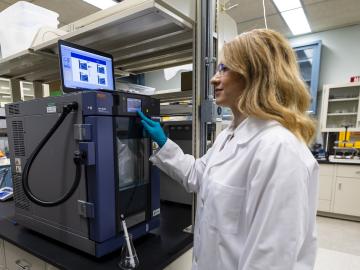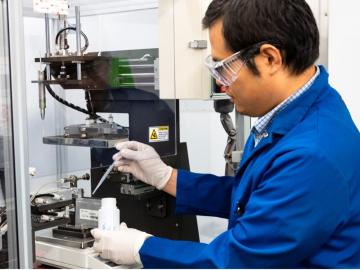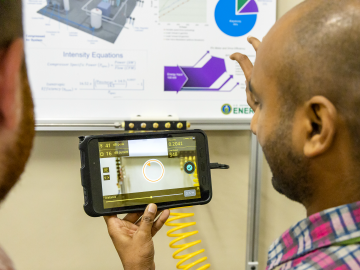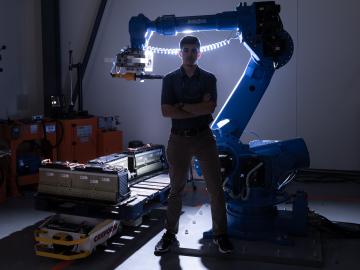
Filter News
Area of Research
- Advanced Manufacturing (1)
- Biology and Environment (15)
- Building Technologies (1)
- Computational Engineering (2)
- Computer Science (10)
- Energy Science (56)
- Energy Sciences (1)
- Fusion and Fission (3)
- Fusion Energy (2)
- Isotopes (12)
- Materials (30)
- Materials for Computing (4)
- Mathematics (1)
- National Security (8)
- Neutron Science (4)
- Nuclear Science and Technology (4)
- Quantum information Science (3)
- Supercomputing (21)
- Transportation Systems (1)
News Type
News Topics
- (-) Computer Science (56)
- (-) Cybersecurity (9)
- (-) Energy Storage (45)
- (-) Isotopes (18)
- (-) Microscopy (22)
- (-) Physics (20)
- (-) Polymers (15)
- (-) Space Exploration (10)
- 3-D Printing/Advanced Manufacturing (47)
- Advanced Reactors (15)
- Artificial Intelligence (25)
- Big Data (29)
- Bioenergy (40)
- Biology (48)
- Biomedical (24)
- Biotechnology (11)
- Buildings (31)
- Chemical Sciences (22)
- Clean Water (21)
- Composites (14)
- Coronavirus (17)
- Critical Materials (14)
- Emergency (1)
- Environment (88)
- Exascale Computing (4)
- Fossil Energy (1)
- Frontier (4)
- Fusion (18)
- Grid (29)
- High-Performance Computing (23)
- Hydropower (8)
- Irradiation (2)
- ITER (4)
- Machine Learning (24)
- Materials (45)
- Materials Science (49)
- Mathematics (8)
- Mercury (7)
- Molten Salt (5)
- Nanotechnology (18)
- National Security (20)
- Neutron Science (37)
- Nuclear Energy (35)
- Partnerships (4)
- Quantum Computing (6)
- Quantum Science (17)
- Security (8)
- Simulation (17)
- Statistics (1)
- Summit (10)
- Transportation (48)
Media Contacts

Raina Setzer knows the work she does matters. That’s because she’s already seen it from the other side. Setzer, a radiochemical processing technician in Oak Ridge National Laboratory’s Isotope Processing and Manufacturing Division, joined the lab in June 2023.

Currently, the biggest hurdle for electric vehicles, or EVs, is the development of advanced battery technology to extend driving range, safety and reliability.

The common sounds in the background of daily life – like a refrigerator’s hum, an air conditioner’s whoosh and a heat pump’s buzz – often go unnoticed. These noises, however, are the heartbeat of a healthy building and integral for comfort and convenience.

Carl Dukes’ career as an adept communicator got off to a slow start: He was about 5 years old when he spoke for the first time. “I’ve been making up for lost time ever since,” joked Dukes, a technical professional at the Department of Energy’s Oak Ridge National Laboratory.

Oak Ridge National Laboratory researchers are taking fast charging for electric vehicles, or EVs, to new extremes. A team of battery scientists recently developed a lithium-ion battery material that not only recharges 80% of its capacity in 10

Madhavi Martin brings a physicist’s tools and perspective to biological and environmental research at the Department of Energy’s Oak Ridge National Laboratory, supporting advances in bioenergy, soil carbon storage and environmental monitoring, and even helping solve a murder mystery.

Mike Huettel is a cyber technical professional. He also recently completed the 6-month Cyber Warfare Technician course for the United States Army, where he learned technical and tactical proficiency leadership in operations throughout the cyber domain.

ORNL researchers have developed a training camp to help manufacturing industries reduce energy-related carbon dioxide emissions and improve cost savings.

It was reading about current nuclear discoveries in textbooks that first made Ken Engle want to work at a national lab. It was seeing the real-world impact of the isotopes produced at ORNL

After being stabilized in an ambulance as he struggled to breathe, Jonathan Harter hit a low point. It was 2020, he was very sick with COVID-19, and his job as a lab technician at ORNL was ending along with his research funding.


